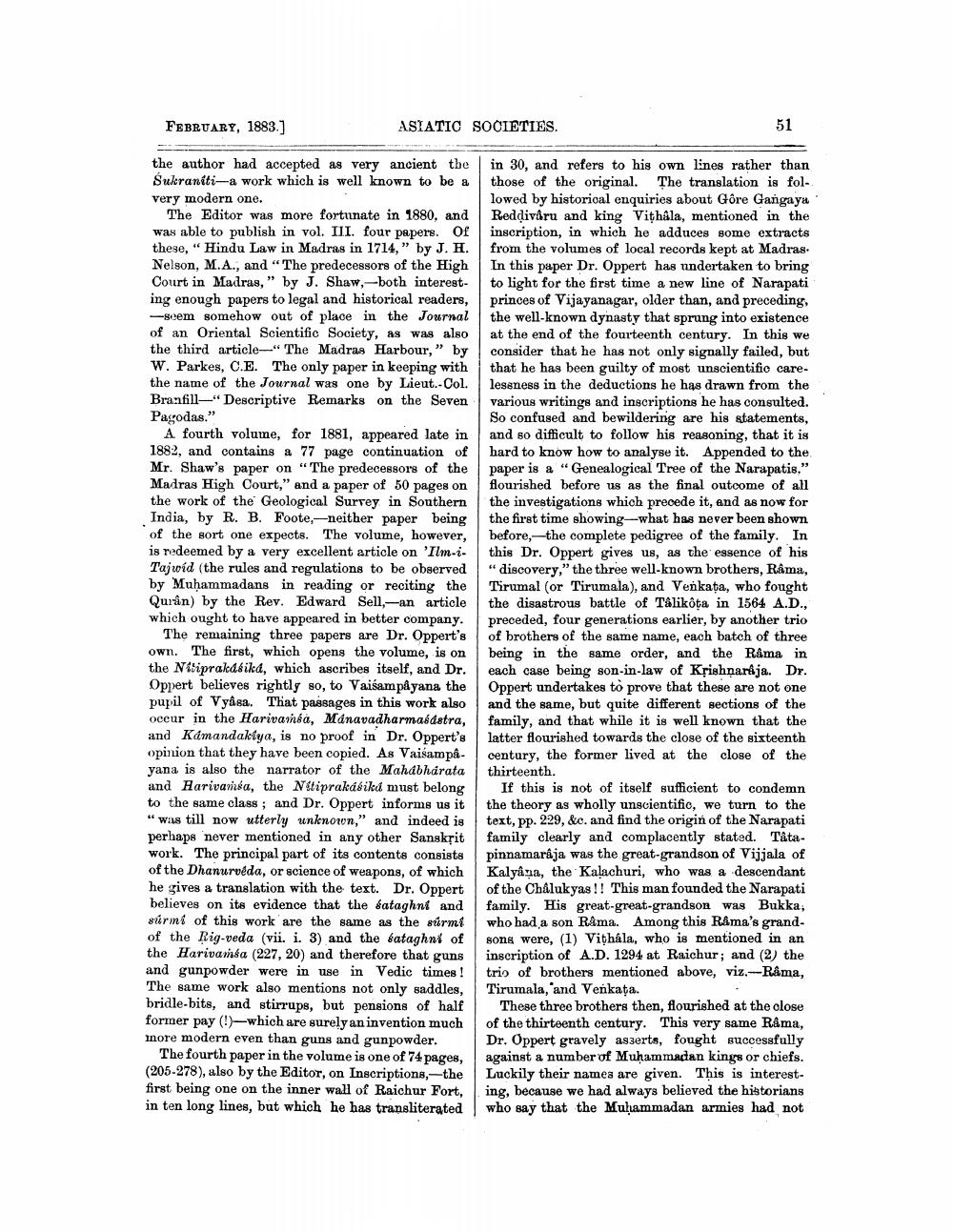________________
FEBRUARY, 1883.]
the author had accepted as very ancient the Sukraníti-a work which is well known to be a very modern one.
ASIATIC SOCIETIES.
The Editor was more fortunate in 1880, and was able to publish in vol. III. four papers. Of these, "Hindu Law in Madras in 1714," by J. H. Nelson, M.A., and "The predecessors of the High Court in Madras, by J. Shaw, both interesting enough papers to legal and historical readers, -seem somehow out of place in the Journal of an Oriental Scientific Society, as was also the third article-" The Madras Harbour," by W. Parkes, C.E. The only paper in keeping with the name of the Journal was one by Lieut.-Col. Branfill" Descriptive Remarks on the Seven Pagodas."
A fourth volume, for 1881, appeared late in 1882, and contains a 77 page continuation of Mr. Shaw's paper on "The predecessors of the Madras High Court," and a paper of 50 pages on the work of the Geological Survey in Southern India, by R. B. Foote, neither paper being of the sort one expects. The volume, however, is redeemed by a very excellent article on 'Ilm-iTajwid (the rules and regulations to be observed by Muhammadans in reading or reciting the Quran) by the Rev. Edward Sell, an article which ought to have appeared in better company.
The remaining three papers are Dr. Oppert's own. The first, which opens the volume, is on the Nitiprakdéikd, which ascribes itself, and Dr. Oppert believes rightly so, to Vaisampayana the pupil of Vyasa. That passages in this work also occur in the Harivaméa, Mánavadharmasastra, and Kamandaktya, is no proof in Dr. Oppert's opinion that they have been copied. As Vaisampåyana is also the narrator of the Mahabharata and Harivamsa, the Nitiprakásiká must belong to the same class; and Dr. Oppert informs us it "was till now utterly unknown," and indeed is perhaps never mentioned in any other Sanskrit work. The principal part of its contents consists of the Dhanurvéda, or science of weapons, of which he gives a translation with the text. Dr. Oppert believes on its evidence that the sataghnt and súrmi of this work are the same as the surmi of the Rig-veda (vii. i. 3) and the bataghni of the Harivansa (227, 20) and therefore that guns and gunpowder were in use in Vedic times! The same work also mentions not only saddles, bridle-bits, and stirrups, but pensions of half former pay (!)-which are surely an invention much more modern even than guns and gunpowder.
The fourth paper in the volume is one of 74 pages, (205-278), also by the Editor, on Inscriptions, the first being one on the inner wall of Raichur Fort, in ten long lines, but which he has transliterated
51
in 30, and refers to his own lines rather than those of the original. The translation is followed by historical enquiries about Gôre Gangaya Redḍivâru and king Vithala, mentioned in the inscription, in which he adduces some extracts from the volumes of local records kept at Madras. In this paper Dr. Oppert has undertaken to bring to light for the first time a new line of Narapati princes of Vijayanagar, older than, and preceding, the well-known dynasty that sprung into existence at the end of the fourteenth century. In this we consider that he has not only signally failed, but that he has been guilty of most unscientific carelessness in the deductions he has drawn from the various writings and inscriptions he has consulted. So confused and bewildering are his statements, and so difficult to follow his reasoning, that it is hard to know how to analyse it. Appended to the paper is a "Genealogical Tree of the Narapatis." flourished before us as the final outcome of all the investigations which precede it, and as now for the first time showing-what has never been shown before, the complete pedigree of the family. In this Dr. Oppert gives us, as the essence of his "discovery," the three well-known brothers, Râma, Tirumal (or Tirumala), and Venkata, who fought the disastrous battle of Tâlikôṭa in 1564 A.D., preceded, four generations earlier, by another trio of brothers of the same name, each batch of three being in the same order, and the Râma in each case being son-in-law of Krishnaraja. Dr. Oppert undertakes to prove that these are not one and the same, but quite different sections of the family, and that while it is well known that the latter flourished towards the close of the sixteenth century, the former lived at the close of the thirteenth.
If this is not of itself sufficient to condemn the theory as wholly unscientific, we turn to the text, pp. 229, &c. and find the origin of the Narapati family clearly and complacently stated. Tâtapinnamaraja was the great-grandson of Vijjala of Kalyana, the Kalachuri, who was a descendant of the Chalukyas!! This man founded the Narapati family. His great-great-grandson was Bukka, who had a son Râma. Among this Râma's grandsons were, (1) Viṭhála, who is mentioned in an inscription of A.D. 1294 at Raichur; and (2) the trio of brothers mentioned above, viz.-Râma, Tirumala, and Venkata.
These three brothers then, flourished at the close of the thirteenth century. This very same Râma, Dr. Oppert gravely asserts, fought successfully against a number of Muhammadan kings or chiefs. Luckily their names are given. This is interesting, because we had always believed the historians who say that the Muhammadan armies had not




